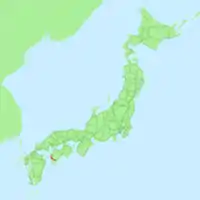Yodo Line
The Yodo Line (予土線, Yodo-sen) is a railway line in Shikoku, Japan, operated by Shikoku Railway Company (JR Shikoku). It connects Kubokawa Station, Shimanto, Takaoka District in Kōchi Prefecture and Uwajima in Ehime Prefecture.[1] Its name comes from the ancient provinces of Iyo (伊予) (now Ehime Prefecture) and Tosa (土佐) (now Kōchi Prefecture), which the line connects.
| Yodo Line | |||
|---|---|---|---|
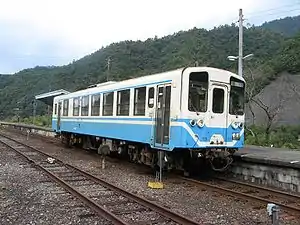 JR Shikoku KiHa 32 series DMU at Ekawasaki Station | |||
| Overview | |||
| Status | In operation | ||
| Owner | JR Shikoku | ||
| Locale | Kōchi, Ehime Prefectures | ||
| Termini | Wakai Kita-Uwajima | ||
| Stations | 20 | ||
| Service | |||
| Type | Heavy rail | ||
| Operator(s) | JR Shikoku | ||
| Rolling stock | KiHa 32 series, KiHa 31 series, KiHa 185 series DMUs | ||
| History | |||
| Opened | 1914 | ||
| Technical | |||
| Line length | 76.3 km (47.4 mi) | ||
| Number of tracks | Entire line single tracked | ||
| Character | Rural | ||
| Track gauge | 1,067 mm (3 ft 6 in) | ||
| Old gauge | 762 mm (2 ft 6 in) | ||
| Electrification | None | ||
| Operating speed | 85 km/h (53 mph) | ||
| |||
Yodo Line | |||||||||||||||||||||||||||||||||||||||||||||||||||||||||||||||||||||||||||||||||||||||||||||||||||||||||||||||||||||||||||||||||||||||||||||||||||||||||||||||||||||||||||||||||||||||||||||||||||||||||||||||||||||||||||||||||||||||||||||||||||||||||||||||||||||||||||||||||||||||||||||||||||||||||||||||
|---|---|---|---|---|---|---|---|---|---|---|---|---|---|---|---|---|---|---|---|---|---|---|---|---|---|---|---|---|---|---|---|---|---|---|---|---|---|---|---|---|---|---|---|---|---|---|---|---|---|---|---|---|---|---|---|---|---|---|---|---|---|---|---|---|---|---|---|---|---|---|---|---|---|---|---|---|---|---|---|---|---|---|---|---|---|---|---|---|---|---|---|---|---|---|---|---|---|---|---|---|---|---|---|---|---|---|---|---|---|---|---|---|---|---|---|---|---|---|---|---|---|---|---|---|---|---|---|---|---|---|---|---|---|---|---|---|---|---|---|---|---|---|---|---|---|---|---|---|---|---|---|---|---|---|---|---|---|---|---|---|---|---|---|---|---|---|---|---|---|---|---|---|---|---|---|---|---|---|---|---|---|---|---|---|---|---|---|---|---|---|---|---|---|---|---|---|---|---|---|---|---|---|---|---|---|---|---|---|---|---|---|---|---|---|---|---|---|---|---|---|---|---|---|---|---|---|---|---|---|---|---|---|---|---|---|---|---|---|---|---|---|---|---|---|---|---|---|---|---|---|---|---|---|---|---|---|---|---|---|---|---|---|---|---|---|---|---|---|---|---|---|---|---|---|---|---|---|---|---|---|---|---|---|---|---|---|---|---|---|---|---|---|---|---|---|---|---|---|---|---|---|---|---|
| |||||||||||||||||||||||||||||||||||||||||||||||||||||||||||||||||||||||||||||||||||||||||||||||||||||||||||||||||||||||||||||||||||||||||||||||||||||||||||||||||||||||||||||||||||||||||||||||||||||||||||||||||||||||||||||||||||||||||||||||||||||||||||||||||||||||||||||||||||||||||||||||||||||||||||||||
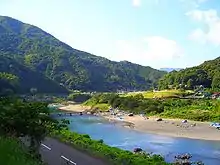
Route Description
The Yodo line is a quiet, rural single track line with passing places at some stations. The line, which is also known as Shimanto Green Line, is one of the most scenic in Japan initially following the Picturesque Shimanto River inland until Ekawasaki. It then winds its way across Ehime Prefecture to Uwajima.[2][3]
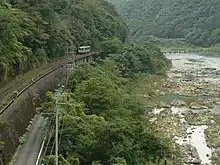
Kubokawa Station on the Dosan Line serves as the departure point for nearly all trains heading west. The first part of the line, to Kawaoku Junction just after Wakai, is not owned by JR but by the Tosa Kuroshio Railway Nakamura Line and therefore attracts an additional fare. Passengers, especially those using the Seishun 18 Kippu, are reminded of this by conductor announcements.[4]
After Wakai, the Nakamura Line turns off and the Yodo Line proper begins. The Yodo line ends at a junction with the Yosan Line just before Kita-Uwajima and trains continue on the Yosan Line into Uwajima.[1]
Services
The Yodo Line has only one sort of service, local trains that stop at every station.
In April 2020 there were five trips in each direction between Kubokawa and Uwajima and an additional three trips each way between Uwajima and Ekawasaki & Chikanaga.[5]
Most services are wanman (driver-only) operated.
Stations
- All trains run through to Kubokawa on the Dosan Line and Uwajima on the Yosan Line.
- All trains on the Yodo Line are local trains and stop at all stations.
- None of the intermediate stations along the line have a staffed ticket office.[1]
- Trains can pass one another at stations marked "◇" and "^" and cannot pass at those marked "|".
| Station No. | Station | Japanese | Distance (km) | Transfers | Location | |||
|---|---|---|---|---|---|---|---|---|
| Between stations |
From Wakai | |||||||
| TK26 | Kubokawa | 窪川 | - | 4.4 | Dosan Line (K26) | ◇ | Shimanto, Takaoka District | Kōchi |
| Via the Tosa Kuroshio Railway Nakamura Line | ||||||||
| TK27 G27 |
Wakai | 若井 | 4.4 | 0.0 | Tosa Kuroshio Railway Nakamura Line (TK27) (for Nakamura) | | | Shimanto, Takaoka District | Kōchi |
| Kawaoku Junction | 川奥信号場 | - | (3.6) | Official branch point for Nakamura Line and Yodo Line | ◇ | Kuroshio, Hata District | ||
| G28 | Iejigawa | 家地川 | 5.8 | 5.8 | | | Shimanto, Takaoka District | ||
| G29 | Utsuigawa | 打井川 | 4.9 | 10.7 | | | |||
| G30 | Tosa-Taishō | 土佐大正 | 6.9 | 17.6 | ◇ | |||
| G31 | Tosa-Shōwa | 土佐昭和 | 8.9 | 26.5 | | | |||
| G32 | Tōkawa | 十川 | 4.5 | 31.0 | | | |||
| G33 | Hage | 半家 | 7.9 | 38.9 | | | Shimanto | ||
| G34 | Ekawasaki | 江川崎 | 3.8 | 42.7 | ◇ | |||
| G35 | Nishigahō | 西ヶ方 | 2.7 | 45.4 | | | |||
| G36 | Matsuchi | 真土 | 5.9 | 51.3 | | | Matsuno, Kitauwa District | Ehime | |
| G37 | Yoshinobu | 吉野生 | 1.7 | 53.0 | ◇ | |||
| G38 | Matsumaru | 松丸 | 2.3 | 55.3 | | | |||
| G39 | Izume | 出目 | 3.5 | 58.8 | | | Kihoku, Kitauwa District | ||
| G40 | Chikanaga | 近永 | 1.6 | 60.4 | ◇ | |||
| G41 | Fukata | 深田 | 2.1 | 62.5 | | | |||
| G42 | Ōuchi | 大内 | 2.9 | 65.4 | | | Uwajima | ||
| G43 | Futana | 二名 | 1.5 | 66.9 | | | |||
| G44 | Iyo-Miyanoshita | 伊予宮野下 | 2.2 | 69.1 | ◇ | |||
| G45 | Muden | 務田 | 0.9 | 70.0 | | | |||
| G46 | Kita-Uwajima | 北宇和島 | 6.3 | 76.3 | Yosan Line (U27) (for Matsuyama) | ◇ | ||
| Through to Uwajima via the Yosan Line | ||||||||
| G47 | Uwajima | 宇和島 | 1.5 | 77.8 | ^ | Uwajima | Ehime | |
History
In 1914, the Uji Light Railway Co. opened a 762 mm (2 ft 6 in) gauge line 18 km between Uwajima and Chikanaga.[6] In 1923, the line was extended 7 km from Chikanaga to Yoshino.[7] In 1931 the Uwajima Railway began operating a single gasoline-powered locomotive.
The Uwajima Railway was nationalised by Japanese Government Railways in 1933, becoming the Uwajima Line; Miyanoshita Station was renamed Iyo-Miyanoshita Station, Nakano became Futana, and Yoshino was renamed Yoshinobu.[8]
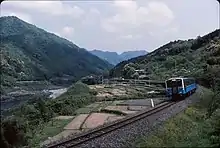
In 1941, the line was re-gauged to 1,067 mm (3 ft 6 in), the section between Uwajima and Muden replaced by a new route, Kita-Uwajima became the line's starting point and Takagushi and Mitsuma stations on the old section were closed.[9]
The 10 km Yoshinobu - Ekawasaki section opened in 1953, and the 43 km Ekawasaki - Wakai section opened in 1974, linking to the Dosan Line with the line renamed as the Yodo Line. In the same year, CTC signalling was commissioned, and freight operations ceased.
References
- "Shikoku Railway Route Map" (PDF). JR Shikoku. p. 16. Retrieved 1 April 2020.
- Zarifeh, Ramsey (2002), Japan by Rail, Hindhead, surrey: Trailblazer, ISBN 1-873756-23-2
- "Train Operation Information". JR Shikoku. Retrieved 3 April 2020.
- "Shikoku Railway Route Map" (PDF). JR Shikoku. p. 6. Retrieved 1 April 2020.
- "Train times and stops - Search for route". Hyperdia. Retrieved 3 April 2020.
- "Light Rail Transport starts". National Diet Library Digital Collections (in Japanese). 22 October 1914. Retrieved 3 April 2020.
- "Regional Rail Transit". National Diet Library Digital Collections (in Japanese). 25 December 1923. Retrieved 3 April 2020.
- "Ministry of Railways Notifications 330 & 331". National Diet Library Digital Collections (in Japanese). 25 July 1933. Retrieved 3 April 2020.
- "Ministry of Railways Notifications 126, 127 & 128". National Diet Library Digital Collections (in Japanese). 10 June 1941. Retrieved 3 April 2020.
External links
| Wikimedia Commons has media related to Yodo Line. |
- JR Shikoku official website (in Japanese)
